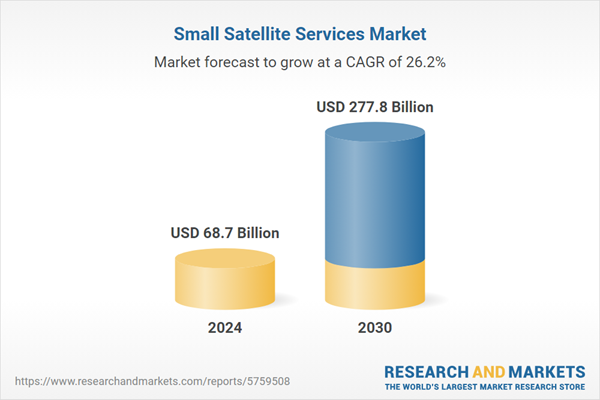The global market for Small Satellite Services was valued at US$68.7 Billion in 2024 and is projected to reach US$277.8 Billion by 2030, growing at a CAGR of 26.2% from 2024 to 2030. This comprehensive report provides an in-depth analysis of market trends, drivers, and forecasts, helping you make informed business decisions. The report includes the most recent global tariff developments and how they impact the Small Satellite Services market.
Segments: Application (Communication, Remote Sensing, Science & Technology and Education, Other Applications); Platform (CubeSat, Nanosatellite, Microsatellite, Minisatellite).
Geographic Regions/Countries: World; United States; Canada; Japan; China; Europe (France; Germany; Italy; United Kingdom; and Rest of Europe); Asia-Pacific; Rest of World.
The analysts continuously track trade developments worldwide, drawing insights from leading global economists and over 200 industry and policy institutions, including think tanks, trade organizations, and national economic advisory bodies. This intelligence is integrated into forecasting models to provide timely, data-driven analysis of emerging risks and opportunities.
Global Small Satellite Services Market - Key Trends and Drivers Summarized
Why Are Small Satellite Services Critical for Modern Data-Driven Applications?
Small satellite services are critical for modern data-driven applications as they provide high-resolution Earth observation, remote sensing, communication, and navigation capabilities that support a wide range of sectors, including agriculture, defense, telecommunications, and environmental monitoring. Small satellites, such as CubeSats, Nanosats, and Microsats, are cost-effective, lightweight, and flexible alternatives to traditional large satellites, making them ideal for rapid deployment and diverse mission profiles. The increasing demand for high-frequency, low-latency data services, driven by the proliferation of IoT, smart cities, and connected devices, is propelling the adoption of small satellite services. These satellites play a vital role in enabling real-time monitoring, disaster management, climate change analysis, and broadband connectivity in remote and underserved regions.How Are Technological Advancements Accelerating the Growth of Small Satellite Services?
Technological advancements are accelerating the growth of small satellite services by enhancing miniaturization, propulsion, power systems, and payload capabilities. The development of high-resolution cameras, advanced sensors, and data analytics tools is enabling small satellites to capture detailed imagery and generate actionable insights for end-users. The integration of AI, machine learning, and cloud computing in satellite data processing is revolutionizing the delivery of value-added services, such as predictive analytics and automated decision-making. The emergence of low-cost, reusable launch vehicles and multi-launch options is reducing the cost of deploying small satellites, making space more accessible to private companies, startups, and research institutions. These advancements are driving the commercialization of small satellite services and fostering the growth of the new space economy.Which Market Segments Are Driving the Demand for Small Satellite Services?
Types include CubeSats, Nanosats, Microsats, and Minisats, with CubeSats and Nanosats leading the market due to their affordability, versatility, and ease of deployment. Applications encompass Earth observation, communication, navigation, remote sensing, and scientific research, with communication and earth observation holding the largest market shares owing to the demand for high-resolution imagery and data analytics for environmental monitoring, agriculture, and urban planning. End-users include government and defense agencies, commercial enterprises, and academic institutions, with the commercial segment witnessing rapid growth driven by the demand for data services in telecommunications, finance, and logistics. Geographically, North America and Europe are the largest markets due to their advanced space programs and investments in satellite infrastructure, while Asia-Pacific is emerging as a high-growth region driven by increasing participation from countries such as India, China, and Japan.What Are the Key Drivers of Growth in the Small Satellite Services Market?
The growth in the small satellite services market is driven by several factors, including the increasing demand for high-resolution Earth observation data, the rising use of small satellites in communication, navigation, and remote sensing, and technological advancements in miniaturization, propulsion, and power systems. The focus on low-cost, high-frequency launch services and the development of small satellite constellations for real-time data and analytics are driving market adoption across diverse sectors. The growing demand for small satellite services in defense, intelligence, and national security applications is expanding the market reach. The integration of AI, machine learning, and cloud computing in satellite data processing and the emergence of subscription-based and on-demand satellite services are creating new opportunities for market growth. Additionally, the increasing collaborations between satellite operators, service providers, and governments and the rising investments in R&D for next-generation small satellite technologies are further supporting market expansion.Report Scope
The report analyzes the Small Satellite Services market, presented in terms of units. The analysis covers the key segments and geographic regions outlined below.Segments: Application (Communication, Remote Sensing, Science & Technology and Education, Other Applications); Platform (CubeSat, Nanosatellite, Microsatellite, Minisatellite).
Geographic Regions/Countries: World; United States; Canada; Japan; China; Europe (France; Germany; Italy; United Kingdom; and Rest of Europe); Asia-Pacific; Rest of World.
Key Insights:
- Market Growth: Understand the significant growth trajectory of the CubeSat segment, which is expected to reach US$19.5 Billion by 2030 with a CAGR of a 14.0%. The Nanosatellite segment is also set to grow at 30.2% CAGR over the analysis period.
- Regional Analysis: Gain insights into the U.S. market, valued at $19.8 Billion in 2024, and China, forecasted to grow at an impressive 25.5% CAGR to reach $43.3 Billion by 2030. Discover growth trends in other key regions, including Japan, Canada, Germany, and the Asia-Pacific.
Why You Should Buy This Report:
- Detailed Market Analysis: Access a thorough analysis of the Global Small Satellite Services Market, covering all major geographic regions and market segments.
- Competitive Insights: Get an overview of the competitive landscape, including the market presence of major players across different geographies.
- Future Trends and Drivers: Understand the key trends and drivers shaping the future of the Global Small Satellite Services Market.
- Actionable Insights: Benefit from actionable insights that can help you identify new revenue opportunities and make strategic business decisions.
Key Questions Answered:
- How is the Global Small Satellite Services Market expected to evolve by 2030?
- What are the main drivers and restraints affecting the market?
- Which market segments will grow the most over the forecast period?
- How will market shares for different regions and segments change by 2030?
- Who are the leading players in the market, and what are their prospects?
Report Features:
- Comprehensive Market Data: Independent analysis of annual sales and market forecasts in US$ Million from 2024 to 2030.
- In-Depth Regional Analysis: Detailed insights into key markets, including the U.S., China, Japan, Canada, Europe, Asia-Pacific, Latin America, Middle East, and Africa.
- Company Profiles: Coverage of players such as Antrix Corporation Ltd., Astro Digital, Capella Space, DigitalGlobe, EchoStar Corporation and more.
- Complimentary Updates: Receive free report updates for one year to keep you informed of the latest market developments.
Some of the 42 companies featured in this Small Satellite Services market report include:
- Antrix Corporation Ltd.
- Astro Digital
- Capella Space
- DigitalGlobe
- EchoStar Corporation
- Eutelsat SA
- Globalstar, Inc.
- Iceye OY
- Inmarsat plc
- Iridium Communications, Inc.
- KVH Industries, Inc.
- Mallon Technology
- Remote Sensing Solutions.
- Satellite Imaging Corporation (SIC)
- Satellogic
- Singapore Telecommunications Ltd. (Singtel)
- Telesat
- The Sanborn Map Company, Inc.
- ViaSat, Inc.
Tariff Impact Analysis: Key Insights for 2025
Global tariff negotiations across 180+ countries are reshaping supply chains, costs, and competitiveness. This report reflects the latest developments as of April 2025 and incorporates forward-looking insights into the market outlook.The analysts continuously track trade developments worldwide, drawing insights from leading global economists and over 200 industry and policy institutions, including think tanks, trade organizations, and national economic advisory bodies. This intelligence is integrated into forecasting models to provide timely, data-driven analysis of emerging risks and opportunities.
What’s Included in This Edition:
- Tariff-adjusted market forecasts by region and segment
- Analysis of cost and supply chain implications by sourcing and trade exposure
- Strategic insights into geographic shifts
Buyers receive a free July 2025 update with:
- Finalized tariff impacts and new trade agreement effects
- Updated projections reflecting global sourcing and cost shifts
- Expanded country-specific coverage across the industry
Table of Contents
I. METHODOLOGYII. EXECUTIVE SUMMARY2. FOCUS ON SELECT PLAYERSIII. MARKET ANALYSISIV. COMPETITION
1. MARKET OVERVIEW
3. MARKET TRENDS & DRIVERS
4. GLOBAL MARKET PERSPECTIVE
UNITED STATES
CANADA
JAPAN
CHINA
EUROPE
FRANCE
GERMANY
ITALY
UNITED KINGDOM
REST OF EUROPE
ASIA-PACIFIC
REST OF WORLD
Companies Mentioned (Partial List)
A selection of companies mentioned in this report includes, but is not limited to:
- Antrix Corporation Ltd.
- Astro Digital
- Capella Space
- DigitalGlobe
- EchoStar Corporation
- Eutelsat SA
- Globalstar, Inc.
- Iceye OY
- Inmarsat plc
- Iridium Communications, Inc.
- KVH Industries, Inc.
- Mallon Technology
- Remote Sensing Solutions.
- Satellite Imaging Corporation (SIC)
- Satellogic
- Singapore Telecommunications Ltd. (Singtel)
- Telesat
- The Sanborn Map Company, Inc.
- ViaSat, Inc.
Table Information
| Report Attribute | Details |
|---|---|
| No. of Pages | 244 |
| Published | April 2025 |
| Forecast Period | 2024 - 2030 |
| Estimated Market Value ( USD | $ 68.7 Billion |
| Forecasted Market Value ( USD | $ 277.8 Billion |
| Compound Annual Growth Rate | 26.2% |
| Regions Covered | Global |









